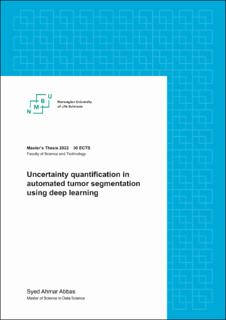| dc.description.abstract | Introduction
Head and neck cancer is one of the leading causes of cancer-related deaths globally and arguably has a long-standing history of impacting human life both medically and economically. Common treatment options which are considered most effective require early and precise delineation of tumors. But this is not an easy task as it requires hours of discussion and iterations for every patient and clinical expertise, and is also prone to human error.
Due to advancements in medical imaging and deep learning, particularly with con- volutional neural networks (CNN), automatic segmentation of tumors has become a hot topic for researchers, and results from different studies have shown prom- ising outcomes. However, these auto delineation algorithms are still far from per- fect, and given the nature of their use, their efficacy in the clinical environment is a hot debate. One of the reasons for the low acceptance of these CNN-based mod- els is their indecipherable black-box nature and inability to quantify and visualize confidence in their delineations.
In this thesis, we have proposed monte carlo dropouts based technique to visu- alize uncertainty in the predictions of convolutional neural networks using V-net architecture to increase the interpretability of the model. This is done through visualizing uncertainties in the input feature selection of the model and also its predictions. Moreover, we have tabled a novel approach to quantify confidence in predictions with a single comparable value as a percentage for easy interpretabil- ity of the auto-segmentation to the clinicians.
Methodology
Monte carlo methods are used to obtain the probabilistic distribution of the out- comes for a numerical problem by repeated sampling. In this thesis, we are using the same approach to find uncertainties in the prediction and input feature se- lection of CNN-based automatic tumor segmentation model. The dataset being used for this study consists of 197 patients diagnosed with head and neck tumors. For repeated sampling, we have used dropout layers with two different rates in the model to randomly disable neurons while making predictions, this setup ensures to have slightly different predictions for the same image in each iteration. The vari- ance in these predictions of each voxel is then visualized as an uncertainty map of the prediction, higher variance defines an uncertain region.
For input feature importance, we have used guided backpropagation which high- lights only those voxels which had a positive gradient in the backpropagation pass. The approach to finding uncertainty in input feature importance is the same as for prediction, that is to find and visualize pixel-wise variance in feature selection over all samples drawn from the same patient scan.
Moreover, to quantify uncertainty in prediction, we have used the approach to estimate segmentation dice score from the overlap metric of uncertainty map and segmentation from the model. This was done by training a separate regression model, with overlap dice score from uncertainty map and prediction as the inde- pendent variable and segmentation dice as the target.
Results
Results from the input feature selection of the model concur with the previous studies on the subject done by NMBU healthcare data science group. For visu- alizing uncertainties, the uncertainty maps in the prediction and feature selection were found to be highlighting regions with potential false predictions with ac- ceptable precision. Hence increasing the interpretability of the CNN model used to make predictions and assisting clinicians to focus on uncertain regions in the auto-delineated scan.
For quantification of uncertainty in prediction, our approach of using a separate regression model for segmentation dice estimation achieved an acceptable perform- ance measured in coefficient of determination R2.
Conclusion
The outcomes of this thesis exhibit the efficacy of using monte carlo approach to obtain uncertainty in predictions made by CNN model, hence increasing inter- pretability and potentially acceptability of deep learning models for automated segmentation of tumors in clinical settings. | en_US |

